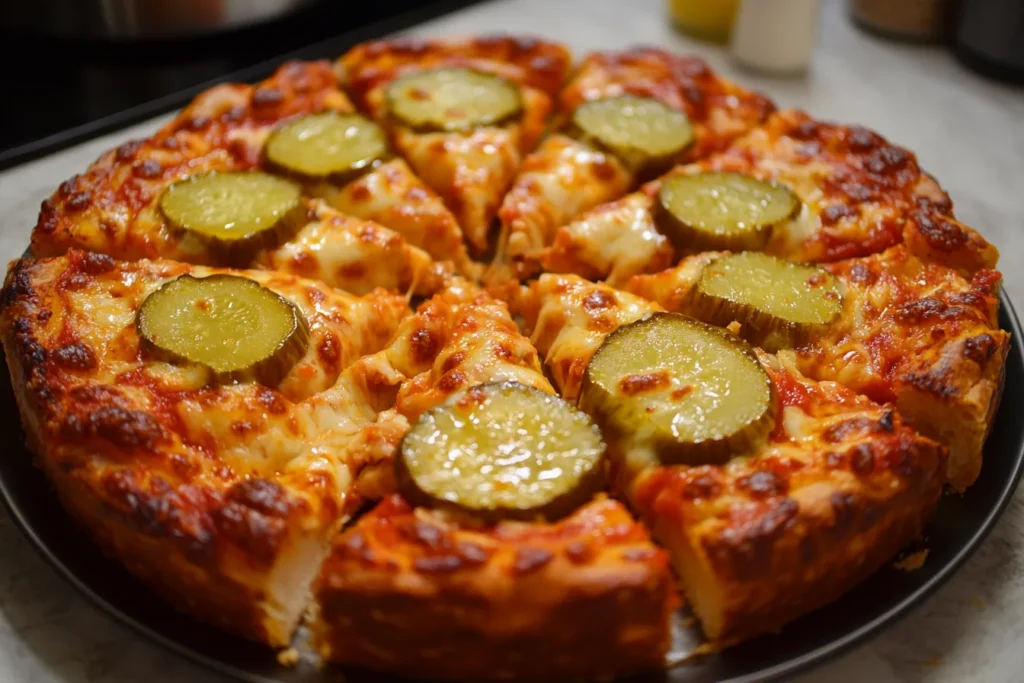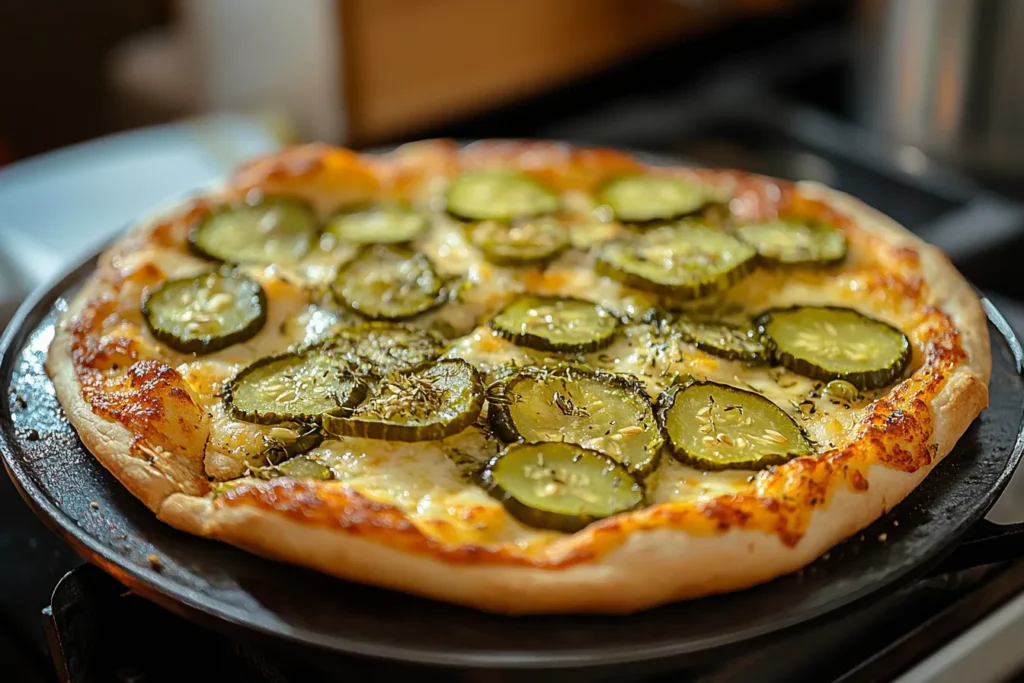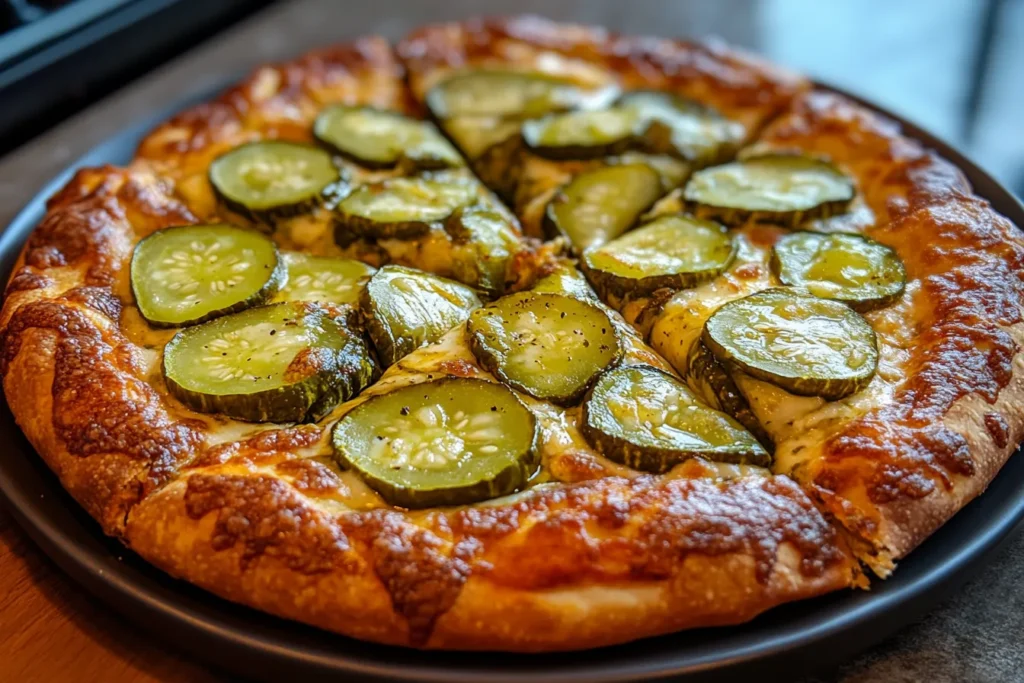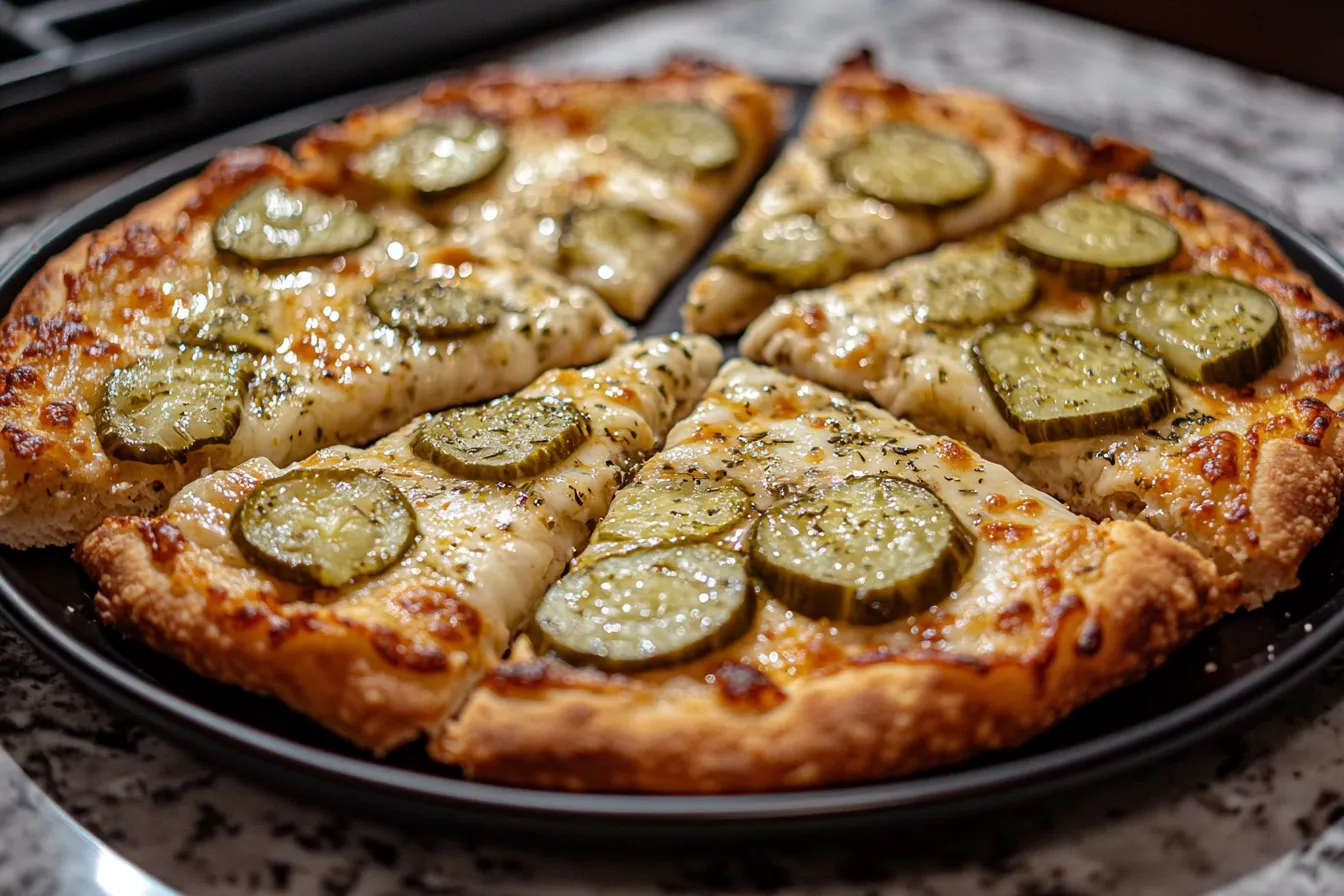Have you heard about pickle pizza and wondered, “Is it actually healthy?” You’re not alone—this trendy combination has people talking, but many are curious about its nutritional value. Pickle pizza is an unexpected twist on the classic pie, replacing traditional heavy toppings with tangy, low-calorie pickles that can lighten things up. If you’ve ever felt torn between indulging in pizza and sticking to healthier choices, pickle pizza might just be the compromise you’ve been searching for. I’ll admit, I was skeptical at first, but after trying it, I realized it’s not only delicious but also a fun way to switch up pizza night without overloading on calories. Let’s dive into what makes pickle pizza unique and whether it earns a spot on your “healthy-ish” menu!
List Of Contents
1. Introduction to Pickle Pizza
What is pickle pizza?
Pickle pizza is a creative twist on traditional pizza; unlike the usual toppings such as pepperoni or sausage, it features tangy, flavorful pickles as its standout ingredient. Originally introduced in niche pizzerias, this unusual combination has rapidly gained traction, becoming a celebrated option for its unique flavor profile and visual appeal. A typical slice includes a standard pizza crust topped with a creamy or tomato-based sauce, cheese, and a generous layer of sliced pickles. Additionally, it is often complemented by toppings like garlic or dill, which enhance its bold and refreshing taste. Check out more recipes here.
Origins and Popularity
The rise of pickle pizza can be traced back to the growing popularity of unconventional pizza toppings, a trend that caters to adventurous eaters seeking bold and unique flavors. In addition to this, the widespread influence of social media platforms like Instagram and TikTok has played a massive role in elevating its status, with users eagerly sharing vibrant photos and viral videos of this innovative dish. As a result, pickle pizza has transformed from a niche offering into a mainstream sensation. Furthermore, pizzerias across the United States, ranging from New York to the Midwest, have enthusiastically embraced this culinary phenomenon. Many establishments have gone beyond the basics, adding their spin with varying sauces like ranch or garlic cream, Consequently, pickle pizza has solidified its place as a must-try option for foodies and casual diners alike. Check out more recipes here.
2. Nutritional Breakdown of Pickle Pizza
Understanding whether pickle pizza is healthy requires a closer look at its key ingredients.
- Dough: Usually made from refined flour, pizza dough contributes a significant amount of calories and carbohydrates. Health-conscious variations, such as whole wheat or cauliflower crusts, offer fewer carbs and more fiber.
- Cheese: Mozzarella is the go-to cheese for pickle pizza. While it’s rich in calcium and protein, it also contains saturated fat, which can contribute to high cholesterol levels if consumed in excess.
- Pickles: High in sodium but low in calories, pickles are a surprising source of certain nutrients like vitamin K and antioxidants.
- Sauces: Ranch dressing or creamy sauces are commonly used, adding flavor but also introducing extra fat and calories. Tomato-based sauces offer fewer calories and additional vitamins.
Each ingredient contributes its nutritional profile, making it a calorie-dense option depending on portion sizes and preparation methods. Check out more recipes here.
3. The Role of Pickles in Nutrition

Nutritional Benefits of Pickles
Pickles are a fermented food, often lauded for their probiotic content. Fermentation introduces beneficial bacteria that support gut health, potentially improving digestion and boosting the immune system. Additionally, pickles are rich in vitamin K, an essential nutrient for blood clotting and bone health. Check out more recipes here.
Sodium Content and Health Implications
The main issue with pickles lies in their elevated sodium levels. A single slice of pickle pizza can deliver up to 40% of your daily sodium allowance. Excessive sodium consumption is linked to high blood pressure, heart disease, and kidney problems, making moderation essential. Check out more recipes here.
4. Cheese and Its Impact on Health
Types of Cheese Commonly Used
Mozzarella is the star of most pickle pizzas. Variations like cheddar, Parmesan, or even vegan cheeses are also used, but they come with different nutritional profiles:
- Mozzarella: Lower in fat than most cheeses, with around 70-80 calories per ounce.
- Cheddar: Rich in flavor but higher in calories and fat.
- Vegan Cheese: Lower in cholesterol but often includes additives.
Fat, Protein, and Calcium Content
Cheese is an excellent source of calcium and protein, which are vital for bone health and muscle repair. However, the saturated fat in cheese can contribute to cardiovascular issues if consumed in excess. Opting for reduced-fat or plant-based alternatives can make a pickle pizza more heart-healthy. Check out more recipes here.
5. The Base: Pizza Crust Considerations
Caloric Content of Various Crust Types
The pizza crust can make or break the healthiness of any pizza.
- Refined Flour Crust: High in calories, with minimal fiber or nutrients.
- Whole Wheat Crust: Offers more fiber, aiding digestion and helping maintain stable blood sugar levels.
- Cauliflower Crust: A low-carb option with fewer calories, making it ideal for keto or gluten-free diets.
Whole Wheat vs Refined Flour Crusts
Whole wheat crusts are a healthier option because they are less processed, retain more nutrients, and provide sustained energy. However, they can alter the traditional flavor and texture, which might not appeal to everyone.
6. Sauce Choices: Healthy or Not?
Ranch Dressing vs Traditional Tomato Sauce
Pickle pizza often uses ranch dressing as its base, offering a creamy, tangy flavor that pairs perfectly with the briny taste of pickles. However, the choice of sauce significantly impacts the overall nutritional profile of the pizza:
- Ranch Dressing: While it enhances the flavor with its creamy texture and tangy taste, ranch dressing contains high amounts of saturated fats and calories, averaging around 150 calories per two tablespoons. Additionally, it contributes to a higher fat content, which may not align with heart-healthy dietary goals.
- Tomato Sauce: As an alternative, tomato sauce is a lighter option, containing approximately 15 calories per tablespoon. It is also rich in antioxidants such as lycopene, which supports heart health and helps reduce inflammation. Moreover, tomato sauce often includes natural vitamins like vitamin C and potassium, making it a more nutrient-dense choice for health-conscious individuals.
Therefore, while ranch dressing is a popular option for its flavor, tomato sauce offers a healthier alternative that complements pickle pizza without adding excessive calories or fat.
Calories, Sugar, and Fat Comparison
Choosing a healthier sauce can significantly reduce the calorie count. Tomato-based sauces are lower in sugar and fat, making them a more balanced option for health-conscious individuals.
7. Additives in Pickle Pizza
Preservatives in Pickles
Store-bought pickles often contain preservatives like sodium benzoate and artificial coloring. While these ensure a longer shelf life, they may have potential health implications, particularly for individuals with sensitivities.
Additional Seasonings and Their Effects
Common seasonings like garlic, dill, and oregano are natural and provide additional health benefits. However, processed toppings like flavored pickles or pre-mixed spice blends may include hidden sugars or salts.
8. Sodium Overload: A Key Concern
How Much Sodium is Too Much?
The FDA recommends limiting daily sodium intake to 2,300 mg. A single slice of pickle pizza can contain 500–700 mg, meaning even moderate consumption could easily exceed healthy limits.
Pickles, Cheese, and Sauce Contributions
Each layer of pickle pizza contributes to the sodium total:
- Pickles: 300–400 mg per serving
- Cheese: 150–200 mg per ounce
- Sauce: Varies significantly depending on the type
Reducing sodium can be achieved by using low-sodium pickles and limiting the amount of cheese or sauce.
9. Pickle Pizza vs Traditional Pizza
Healthier or Not?
Pickle pizza can be healthier than traditional pizza if prepared thoughtfully. For example:
- Lower calorie count when compared to meat-heavy pizzas.
- Potential probiotic benefits from pickles.
However, its sodium content and use of calorie-dense sauces may outweigh these advantages for some people.
Caloric and Nutrient Comparison
Traditional pizzas with toppings like pepperoni or sausage are higher in saturated fats and calories. Meanwhile, pickle pizza swaps these for a lower-calorie topping, though the sodium tradeoff remains a significant consideration.
10. Customizing Pickle Pizza for Better Nutrition
Low-Sodium Pickles
Using homemade or low-sodium pickles can dramatically reduce salt levels without sacrificing flavor.
Reduced-Fat Cheese and Healthier Crust Options
Opting for reduced-fat cheese or experimenting with crust alternatives like cauliflower or whole wheat can enhance the nutritional profile of your pickle pizza, making it a better fit for a balanced diet.
11. Dietary Compatibility of Pickle Pizza

Is Pickle Pizza Keto-Friendly?
For those following a keto diet, pickle pizza can fit within dietary guidelines with a few modifications. The pickles themselves are low-carb, while cheese provides the high-fat content that keto enthusiasts prioritize. However, the crust often contains too many carbohydrates unless substituted with cauliflower or almond flour bases.
Vegan and Gluten-Free Options
Pickle pizza can be easily tailored to accommodate both vegan and gluten-free diets, making it an inclusive option for individuals with specific dietary preferences or restrictions.
- Vegan Pickle Pizza: For a plant-based version, replace traditional dairy-based cheese with vegan alternatives made from cashews, soy, or almond milk. Additionally, ensure that the sauce and crust do not contain hidden animal-derived ingredients, such as whey or casein, which can sometimes be found in pre-made pizza dough or sauces.
- Gluten-Free Pickle Pizza: Crafting a gluten-free crust is simple with the use of flours like rice, almond, or chickpea flour. Moreover, pre-made gluten-free pizza bases are widely available for those looking for convenience. Pairing this crust with naturally gluten-free toppings like pickles and plant-based sauces ensures that no trace of gluten interferes with the dish.
As a result, these modifications ensure that dietary preferences and restrictions don’t prevent anyone from enjoying the unique and trendy flavors of pickle pizza. Whether vegan, gluten-free, or both, this versatile dish can be adapted without compromising its signature tangy appeal.
12. Pickle Pizza and Digestive Health
Impact of Fermented Pickles
Fermented pickles are abundant in probiotics, which are helpful bacteria that promote a healthy gut. They aid in digestion, improve nutrient absorption, and can even enhance mood by promoting a healthier gut-brain connection. Choosing naturally fermented pickles over vinegar-pickled options ensures maximum probiotic benefits.
Gut Health and Probiotics
While cheese and certain toppings may slow digestion due to their fat content, the probiotics in pickles help counterbalance this. The combined fiber from a whole wheat crust and these probiotics can make pickle pizza gentler on the digestive system when prepared thoughtfully.
13. Allergies and Sensitivities
Dairy and Gluten Sensitivities
Traditional pickle pizza relies heavily on dairy and gluten, making it unsuitable for individuals with:
- Lactose Intolerance: Can cause bloating and discomfort. Lactose-free cheeses are a great alternative.
- Gluten Sensitivity: Gluten-free crust options, like cauliflower or almond flour bases, ensure inclusivity without sacrificing flavor.
Alternatives for Allergen-Free Pickle Pizza
For those with allergies, using plant-based cheeses and allergen-friendly crusts (like cassava flour) allows for a fully customizable and allergen-free pickle pizza experience.
14. Weight Management and Pickle Pizza
Is Pickle Pizza Good for Weight Loss?
While pickle pizza may not traditionally align with weight-loss goals, strategic modifications can make it a better choice:
- Lower-Calorie Crusts: Cauliflower crusts can cut calories significantly.
- Reduced-Fat Cheese: This minimizes calorie and saturated fat intake.
- Portion Control: Stick to one or two slices paired with a side salad to balance calorie consumption.
Portion Control and Calorie Considerations
An average slice of pickle pizza contains 250–350 calories, depending on the crust, cheese, and sauce. Mindful eating practices can prevent overindulgence while allowing you to enjoy this unique treat.
15. Cooking Methods and Health Impacts
Oven-Baked vs Deep-Fried Pizza
Most pickle pizzas are oven-baked, which preserves nutrients and avoids excessive fat content. However, some variations include deep-fried crusts or toppings, which:
- Add unnecessary saturated fats and calories.
- Can negate any potential health benefits of the toppings.
Effects of Cooking on Nutrient Retention
High temperatures can degrade certain nutrients in pickles and cheese. To preserve their benefits:
- Use moderate heat and avoid overcooking.
- Incorporate fresh toppings post-baking to retain nutritional value.
16. Case Studies: Pickle Pizza in Popular Restaurants
Nutritional Analysis of Popular Chains
Several popular chains and pizzerias have embraced pickle pizza. A comparison shows significant variability:
- Restaurant Versions: Often higher in calories and sodium due to larger portions and processed ingredients.
- Homemade Versions: Provide greater control over ingredient quality and portion sizes.
How Homemade Versions Compare
Crafting pickle pizza at home offers:
- Better ingredient control (e.g., choosing low-sodium pickles).
- Reduced reliance on processed components.
By making it yourself, you can tailor the recipe to fit your health goals while still enjoying the trend.
17. Psychological Factors: Cravings and Food Choices
Why Do People Crave Pickles?
Pickle cravings often stem from:
- Sodium deficiency: A rare but possible cause.
- Flavor satisfaction: The tangy, salty taste is highly satisfying, especially for those who enjoy bold flavors.
Balancing Indulgence and Health
Cravings for pickle pizza can be indulged occasionally, but moderation is crucial. Pairing it with nutrient-dense sides like vegetables or leafy greens can help create a balanced meal without overindulging.
18. The Role of Moderation in Health
How Often Can Pickle Pizza Be Part of a Balanced Diet?
Incorporating pickle pizza into your diet occasionally (e.g., once every two weeks) is unlikely to harm your health. The key is to:
- Limit portion sizes.
- Balance it with nutrient-rich meals on other days.
Tips for Maintaining Moderation
- Opt for a smaller serving size.
- Serve with a large side salad or roasted vegetables.
- Use lighter toppings, such as reduced-fat cheese or low-sodium pickles.
19. Cultural Variations in Pickle Pizza
Pickle Pizza in Different Cuisines
Pickle pizza has seen variations across cultures:
- American-Style: Often heavy on cheese and ranch dressing.
- Mediterranean: Incorporates lighter toppings like feta cheese, olives, and fresh dill.
- Asian-Inspired: Features pickled vegetables like kimchi for a spicier twist.
Influence of Cultural Ingredients on Health
Cultural variations often determine the healthiness of the dish. For example, Mediterranean-inspired versions typically include healthier oils and herbs, while American versions lean toward richer, creamier ingredients.
20. Scientific Studies on Pickle Consumption
Research on Health Effects of Pickles
Studies suggest that fermented pickles may:
- Support gut health due to probiotics.
- Reduce inflammation, thanks to antioxidants found in dill and cucumbers.
How It Applies to Pizza
When used on pizza, these benefits may be offset by the sodium and fat content of other ingredients. However, incorporating nutrient-dense alternatives can tip the scale back toward a healthier balance
21. DIY Pickle Pizza: Healthier Recipe Ideas

Using Organic Ingredients
Creating a healthier pickle pizza at home begins with ingredient selection:
- Organic Pickles: Opt for pickles without artificial preservatives or added sugars.
- Whole Wheat or Cauliflower Crusts: These crusts add fiber and reduce carbohydrates.
- Homemade Sauces: Avoid processed ranch or high-sodium tomato sauces by making your own with Greek yogurt or fresh tomatoes.
Health-Focused Modifications
- Replace full-fat mozzarella with part-skim or vegan cheese.
- Include fresh herbs like dill or parsley for added flavor without added sodium.
- Add vegetables like bell peppers, onions, or spinach for additional nutrients.
Crafting your own pizza ensures total control over nutrition and allows you to experiment with healthier alternatives.
22. Popular Diet Trends and Pickle Pizza
How Pickle Pizza Fits into Modern Diet Trends
- Paleo Diet: Substitute traditional crusts with almond flour or cassava flour bases.
- Mediterranean Diet: Incorporate olive oil-based sauces, feta cheese, and fresh vegetables.
- Keto Diet: Cauliflower crust and full-fat cheese make it a keto-friendly option.
Adapting Pickle Pizza to Diverse Lifestyles
These adjustments make pickle pizza more versatile, allowing it to align with various dietary goals while maintaining its unique flavor profile.
23. Pickle Pizza for Children and Families
Nutritional Considerations for Kids
Children can enjoy pickle pizza as an occasional treat. Ensure their slices are:
- Low in sodium to avoid excessive intake.
- Balanced with healthier toppings like vegetables.
Making Family-Friendly and Healthier Versions
For a family-friendly twist:
- Use mild-flavored pickles to suit children’s taste buds.
- Create mini pizzas, allowing each family member to customize their toppings.
- Pair with a nutrient-rich side dish, such as a green salad or roasted broccoli.
24. Social Media Influence on Food Choices
The Rise of Pickle Pizza on Social Media
Pickle pizza has surged in popularity due to its viral appeal. Platforms like Instagram and TikTok have turned this unconventional dish into a visual sensation, with users drawn to its vibrant presentation and novelty.
Health Perceptions vs Reality
While many assume trendy foods are healthier due to their unique ingredients, social media often downplays key nutritional concerns, such as sodium levels. Consumers must stay informed about the health implications of these viral trends.
25. Health Benefits of Ingredients Beyond Pickles
Oregano, Garlic, and Herbs
Herbs like oregano and garlic are often used as toppings for pickle pizza, offering several health benefits:
- Oregano: Contains antioxidants that reduce inflammation.
- Garlic: Supports immunity and cardiovascular health.
- Dill: Promotes digestion and adds a distinct flavor.
Impact on Immunity and Digestion
Incorporating these herbs enhances not just the taste but also the overall nutritional value of pickle pizza. These small additions can make a big difference in balancing indulgence with health.
26. Consumer Awareness: Reading Labels on Ingredients
Identifying Unhealthy Additives
When buying pickles, cheese, or sauces, check for:
- Hidden Sugars: Found in certain pickles and sauces.
- High Sodium Content: Especially prevalent in pickles and processed cheeses.
- Artificial Preservatives: Look for natural alternatives like vinegar in pickles.
Choosing Better Store-Bought Options
To keep your pickle pizza healthy:
- Use low-sodium or organic pickles.
- Opt for natural cheeses with minimal processing.
- Select sauces without added sugars or preservatives.
27. Exploring Alternatives to Pickle Pizza
Other Unique Pizza Toppings
If you’re looking for creative yet healthier pizza options, consider:
- Vegetable-Based Pizzas: Toppings like zucchini, mushrooms, or roasted eggplant.
- Fruit-Inspired Pizzas: Pineapple, figs, or even thinly sliced apples for sweetness.
- Fermented Toppings: Kimchi or sauerkraut for gut-friendly alternatives.
Healthier Creative Combinations
Combining nutrient-dense toppings with low-calorie sauces and crusts can provide a flavorful yet health-conscious meal.
28. Experts’ Opinions on Pickle Pizza
Nutritionists’ Perspectives
Nutrition experts emphasize moderation when indulging in pickle pizza. The high sodium content is the most pressing concern, but it can be mitigated with homemade, healthier versions.
Chefs’ Insights on Ingredient Balance
Professional chefs suggest balancing the intense flavor of pickles with lighter sauces and toppings. Using fresh, quality ingredients is key to making pickle pizza both delicious and nutritious.
29. Debunking Myths About Pickle Pizza
Common Misconceptions
- Myth: Pickle pizza is inherently healthy due to the inclusion of pickles.
- Fact: While pickles provide probiotics, their high sodium content may negate some benefits.
- Myth: All cheeses on pickle pizza are equally unhealthy.
- Fact: Reduced-fat or plant-based cheeses are healthier alternatives.
Facts Backed by Science
Studies support the benefits of fermented foods like pickles but also highlight the risks of excessive sodium. Pairing these foods with nutrient-rich accompaniments can create a balanced meal.
30. Final Verdict: Is Pickle Pizza Healthy?
Summary of Pros and Cons
Pros:
- Pickles offer probiotics and antioxidants.
- Customizable recipes can improve nutritional value.
- Lower-calorie toppings compared to traditional pizzas.
Cons:
- High sodium levels.
- Calorie-dense cheese and creamy sauces.
Recommendations for Consumption
Pickle pizza can be part of a balanced diet if:
- Eaten in moderation.
- Prepared with healthier ingredients like whole wheat crust, low-sodium pickles, and reduced-fat cheese.
- Paired with nutrient-rich sides to balance the meal.
FAQs
- Is pickle pizza safe for pregnant women?
- Yes, if made with pasteurized cheese and low-sodium pickles.
- Can I freeze leftover pickle pizza?
- Yes, but fresh pickles may lose their crunch upon reheating.
- What’s the healthiest sauce for pickle pizza?
- A Greek yogurt-based sauce or homemade tomato sauce.
- Are homemade pickles healthier for pizza?
- Absolutely, as they often have fewer preservatives and lower sodium.
- Does pickle pizza cause bloating?
- High sodium content and cheese might cause bloating in sensitive individuals.
- Is pickle pizza good for gut health?
- Only if made with fermented pickles for probiotic benefits.
- Can I make pickle pizza spicy?
- Yes, by adding jalapeños or spicy pickles.
- Does pickle pizza have gluten?
- Only in the crust unless gluten-free alternatives are used.
- Is pickle pizza better baked or grilled?
- Baking is healthier as it retains nutrients and requires less oil.
- What’s a good pairing with pickle pizza?
- A fresh green salad or roasted vegetables to balance the flavors and nutrients.
